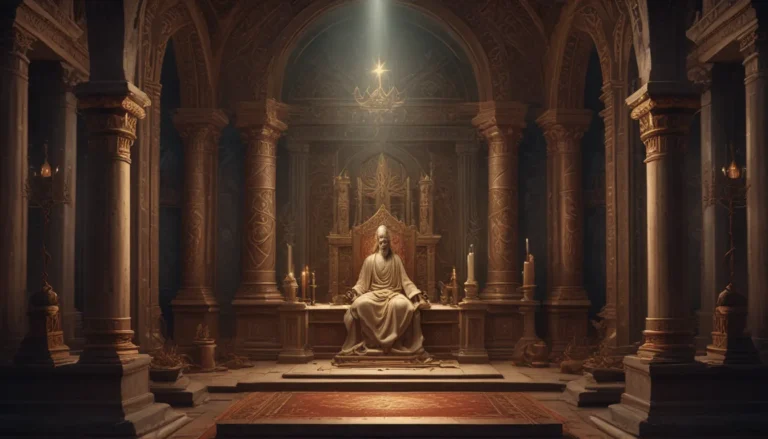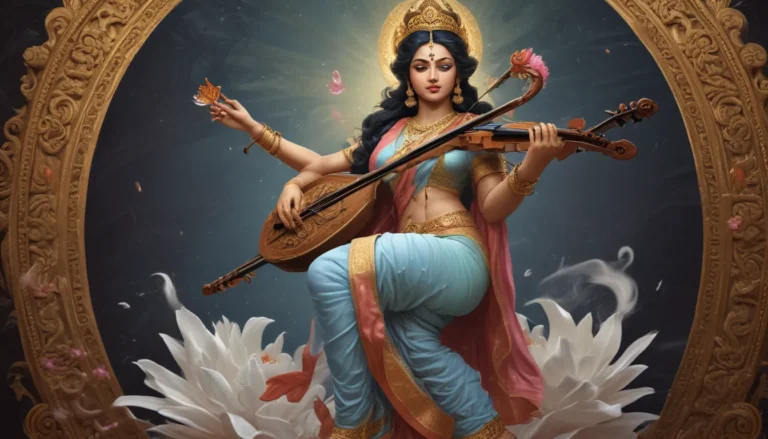The images in our articles may not match the content exactly. They are used to grab your attention, not to show the exact details in the text. The images complement the text but do not replace it.
Welcome to the exploration of Kemeticism, a modern revival of the ancient Egyptian religion that has captured the hearts and minds of many in recent years. Rooted in the rich tapestry of beliefs, rituals, and traditions of ancient Egypt, Kemeticism offers a fascinating pathway to spiritual enlightenment and connection with the divine. Whether you are a seasoned follower of Kemeticism or a curious newcomer, join us on this journey to uncover 20 captivating facts about this ancient religious practice.
Unraveling the Origins of Kemeticism
Kemeticism, also known as Egyptian Neo-paganism, is a contemporary religious movement that seeks to revive and practice the ancient Egyptian religion. Drawing inspiration from the beliefs and traditions of the civilization of ancient Egypt, Kemeticism celebrates the interconnectedness of nature, the importance of ethical living, and the veneration of ancestors.
Delving into the Ancient Egyptian Pantheon
Central to Kemeticism is the worship of a diverse array of gods and goddesses from ancient Egyptian mythology. Deities such as Ra, Osiris, Isis, and Ma’at play significant roles in the spiritual practices and rituals of Kemeticists, guiding them on their spiritual journeys and providing support and guidance.
Celebrating the Reverence for Nature
In Kemeticism, nature is revered as a sacred and interconnected web of existence. Followers of Kemeticism emphasize the harmony between all living beings and the environment, recognizing the profound impact of maintaining a balanced relationship with nature on spiritual well-being.
Exploring Rituals, Offerings, and Ceremonies
Practitioners of Kemeticism engage in a variety of rituals and ceremonies to honor the gods and goddesses, seek guidance from ancestors, and deepen their spiritual connection. Offerings of food, drink, and incense are often presented as symbols of reverence and gratitude.
Nurturing the Importance of Ancestors
Ancestor veneration holds a significant place in Kemeticism, with practitioners seeking guidance, wisdom, and support from their ancestors through rituals and ceremonies. Connecting with one’s lineage and honoring the legacy of those who came before is a cornerstone of Kemeticism.
Decoding Symbolism in Kemeticism
Symbols play a vital role in Kemeticism, serving as powerful representations of key concepts and beliefs. The Ankh, Eye of Horus, and Djed pillar are symbolic icons that embody ideas of life, protection, stability, and spiritual enlightenment within the framework of Kemeticism.
Unveiling the Secrets of the Book of the Dead
The Book of the Dead, also known as the “Book of Coming Forth by Day,” is a revered ancient Egyptian funerary text that forms a central part of Kemeticism. This sacred text guides the deceased through the journey of the afterlife, offering instructions and prayers for a successful transition.
Embracing Reincarnation and the Afterlife
Kemeticism embraces the belief in reincarnation and the continuation of the soul’s journey after death. The ultimate goal for followers of Kemeticism is to attain spiritual enlightenment and union with the divine through a series of incarnations and experiences.
Establishing Temples and Sacred Spaces
Kemeticists often create temples or sacred spaces dedicated to the practice of their faith. These places serve as venues for rituals, ceremonies, community gatherings, and spiritual exploration, fostering a sense of connection and communion with the divine.
Discovering the Role of the Priesthood
Within Kemeticism, a recognized priesthood exists comprising individuals who have undergone specific training and initiation to serve as intermediaries between the gods and the community. These priests play pivotal roles in conducting rituals, offering guidance, and fostering spiritual growth.
Celebrating the Rich Tapestry of Festivals
Throughout the year, practitioners of Kemeticism celebrate various festivals that honor different gods, goddesses, and events from ancient Egyptian mythology. These festivities serve as opportunities for spiritual reflection, communal bonding, and the commemoration of significant cultural milestones.
Embodying Ma’at: The Path to Balance and Harmony
Central to Kemeticism is the concept of Ma’at, embodied by the goddess of truth, justice, and balance. Followers of Kemeticism strive to live in accordance with ethical principles, fostering personal growth, harmony, and alignment with the cosmic order.
The Evolution of Kemeticism as a Modern Religion
While inspired by ancient Egyptian religion, Kemeticism has evolved into a distinct modern spiritual path with its interpretations, practices, and community dynamics. It offers a unique blend of ancient wisdom and contemporary spirituality for individuals seeking spiritual fulfillment and connection.
Unveiling the Ethical Code of Kemeticism
Kemeticism promotes a set of values that include honesty, integrity, compassion, and respect for others as essential aspects of ethical living. These principles guide practitioners in their interactions with fellow human beings, the environment, and the divine.
Embracing the Art of Divination
Divination techniques such as tarot reading, pendulum dowsing, and scrying are sometimes employed by Kemeticists to gain spiritual insights, guidance, and wisdom. These practices serve as tools for accessing deeper levels of consciousness and connecting with the unseen realms.
Initiating into Kemetic Mysteries
Certain practitioners of Kemeticism engage in mystery traditions and initiatory practices that involve stages of spiritual growth, self-discovery, and deepening connections with the divine. These mystical experiences offer profound insights, transformation, and enlightenment to those who undertake them.
Cultivating Community and Fellowship
Kemeticism fosters a sense of community and fellowship among its practitioners, encouraging mutual support, learning, and the sharing of rituals, knowledge, and spiritual experiences. This communal aspect creates a supportive environment for spiritual growth and exploration.
Tracing the Influence of Kemeticism on Popular Culture
The spiritual practices and beliefs of Kemeticism have left a lasting impact on various facets of popular culture, including literature, music, films, and art. The ancient myths, symbols, and rituals of Kemeticism continue to inspire and resonate with individuals worldwide.
Celebrating Diversity within Kemeticism
Within the practice of Kemeticism, there exists a diverse range of beliefs, interpretations, and practices that allow for individual expression, personal connection with deities, and spiritual exploration. This diversity reflects the unique paths and journeys of each practitioner within the Kemetic tradition.
In Conclusion: Embracing the Wisdom of Kemeticism
In conclusion, Kemeticism stands as a fascinating and ancient belief system that offers a glimpse into the spiritual heritage of ancient Egypt. Through its rituals, symbols, deities, and ethical principles, Kemeticism provides a pathway to spiritual enlightenment, personal growth, and connection with the divine.
Whether you are drawn to ancient Egyptian culture, seeking a deeper spiritual connection, or simply curious about different religious traditions, exploring Kemeticism can be a rewarding and enlightening experience. Take the time to delve into the world of Kemeticism, uncover its wisdom and beauty, and embark on a journey of self-discovery and spiritual growth.
FAQs: Exploring Kemeticism
- What is Kemeticism?
-
Kemeticism is a modern religious movement inspired by the ancient Egyptian beliefs and practices.
-
Which deities are worshiped in Kemeticism?
-
Kemeticism involves the worship of various deities from ancient Egyptian mythology, including Ra, Osiris, Isis, and Horus.
-
Is Kemeticism a recognized religion?
-
While not mainstream, Kemeticism has a growing community of followers worldwide.
-
How do Kemeticists practice their faith?
-
Kemeticists engage in rituals, prayers, offerings, and community gatherings to honor the gods and strengthen their spiritual connection.
-
Can anyone practice Kemeticism?
-
Yes, anyone interested in ancient Egyptian spirituality can explore and practice Kemeticism.
-
Where can one learn more about Kemeticism?
-
Books, websites, and online communities dedicated to Kemeticism offer resources for study and practice.
-
Does Kemeticism follow a specific moral code?
-
While emphasizing balance, harmony, and personal growth, Kemeticism does not prescribe a rigid moral code.
-
How does Kemeticism view the afterlife?
-
Kemeticism sees the afterlife as a continuation of the soul’s journey, emphasizing rituals and treatment of the deceased.
-
Are there specific holidays in Kemeticism?
-
Kemeticism celebrates festivals honoring ancient Egyptian deities and mythological events throughout the year.
-
How can one connect with the Kemeticist community?
- Participating in online forums, attending local events, and engaging with experienced practitioners are ways to connect with the Kemeticist community.
Was this page helpful?
We are committed to providing accurate and engaging content through the contributions of real users like you. Our dedicated editors ensure that each fact is thoroughly reviewed for accuracy and reliability. Explore and learn with confidence as you immerse yourself in the diverse insights and information shared on our site. Trust in the authenticity and quality of our content as you delve into the wonders of spirituality, history, and culture.






